Ballyhack
One hundred years ago, the land that is today Ballyhack Golf Club was the Saul Dairy Farm. Pure, unpretentious, and honest—you can feel the soul of Ballyhack in the land.
The club is a mere ten minutes away from downtown Roanoke, Virginia, nestled in the Blue Ridge Mountains to create a private, picturesque golf retreat. From a full-service clubhouse and upscale cottages to a world- class culinary program, time spent at Ballyhack provides a truly immersive experience.
The Lester George-designed course, painted across a vast swath of Virginia’s Roanoke Valley, serves up vivid, expansive views. Ballyhack Golf Club became the second Dormie Network club in 2016, and capital improvement projects have not ceased since its acquisition. The construction of new cottages, a 200-bottle wine cellar, kitchen and dining room remodels, new cart storage facility and an 18-hole, Par 3 Goat Trak are some of the projects undertaken. After updating the logo in 2020, the club’s mark now pays homage to the friendly flock of goats found grazing throughout the course.
“The mountainous terrain offers a completely different feel and theme to the club, as well as the overall golf and dining experience,” explained Ian Sikes, General Manager at Ballyhack. “In the three years that I’ve been here I have seen nothing but improvement and opportunity to elevate the guest experience. There’s a ton of potential for a course that is still relatively young. The only way to go is up.”

HIGHLANDS-STYLE COURSE
Designed in 2009 by Lester George, Ballyhack Golf Club features rugged terrain, gouged-out bunkers and scenic views. Billed as a Scottish Highland-type layout, the course delivers dramatic elevation changes across a 190-acre tract of land. Framed in the Blue Ridge mountains with undulating fairways and enormous greens, Ballyhack Golf Club offers an aesthetic appeal that few courses in the country can match.
Using the dramatic topography of the mountains, George architected bold, contoured greens with rolling fairways as wide as 150 yards. High, grassy dunes dominate the front nine, with holes routed around and between several major ridges.
The 530-yard, Par 5 hole #2 plays off a high dune to a natural ridge, with the fairway encompassing the entire ridge. The 10,000-square-foot green perches precariously on the ridgetop with a drop-off surrounding it.
The back nine features an old-world style double green on the 13th and 15th holes that measures 25,000 square feet. The use of cool-season grasses with native grass dunes on ragged, wind-blown bunker faces deliver time-honored European golf on U.S. soil. The 18th hole, a 480-yard Par 4, plays through a ravine into a 21,000-square-foot punchbowl green where some putts may be well over 100 feet. In the evenings, the 18th green is often lit for guests to engage in friendly nighttime putting competitions.
Difficult terrain and vast scale make the golfer rethink the direct route to the pin. Steep greens, guarded by native roughs, create challenging shots for holes that feel as if they appeared out of the ridges and valleys. The course itself features very few trees, so the vastness of the land takes center stage next to the mountain backdrop. More eye-catching for players are the elevation changes on nearly every hole. Sloping fairways produce unique rolls, placing balls 50 to 60 yards from where a player intended to go.

“The course demands a lot of the player, both mentally and physically. On top of discipline and skill, strategy comes into play on every hole,” Sikes explained. “That’s why the course was a great fit for the State Open of Virginia from 2014 to 2020. It’s a championship-caliber course, which tested more than 144 of the state’s best amateurs and professionals every year.”
As challenging as the 18-hole course can be, an 18-hole, Par 3 Goat Trak opened in June of 2020 to add to course enjoyment. The Goat Trak makes the most of Ballyhack’s picturesque landscape and phenomenal green complexes offering a more fast-paced game, perfect for a second round or a quick afternoon match. Zeon Zoysia tee boxes camouflage themselves out of view from the main course, showcasing views, angles and game strategy not typically experienced on the course’s traditional routing. George visited Ballyhack to select tee box locations that protected the integrity of the original course while remaining a fit to the lay of the land.
“It’s no secret that Ballyhack can be challenging. The Goat Trak is an easier, less stressful way to experience the game and enjoy the evening. It’s also a nice option for groups who are checking in late and don’t have time for the traditional 18,” Sikes said. While on site, remember to say hello to the friendly herd of African Boer goats on the property. They primarily feed on herbaceous plants, but sometimes they cannot resist jumping into a cart to steal a lunch – just another course hazard. Other than an errant nibble, these goats (ten total) were bottle-fed for socialization and bred to be friendly to guests. They spend most of their time eating weeds, sunbathing on rocks and resting at their home near the #12 green. Just like the rest of the team, they love to welcome guests to the course.
Featured Holes
#6
Par 4, 354 yards
Hole #6 offers the gambler’s choice between a drive to the green and certain disaster if the attempt fails. The disciplined play from the tee is a moderate length-long iron or utility club towards the Angel bunker in the hillside. Anything to the left of that starts running out of room across the fairway but puts the player closer to the green. The green is protected by deep bunkers and a long, nasty rough. This hole demonstrates the architect’s intent perfectly – the player must wisely choose where and how to place shots, or suffer
the consequences.
#15
Par 5, 575 yards
Hole #15 drops over 100 feet in elevation from tee to green and gives the player many routes to the hole, fueling many discussions in the clubhouse about how best to conquer it. With the prevailing wind usually against, the player can elect to hit a shorter drive in front of the daunting chasm. This will lead to a short layup, or a longer but more direct second over the hazard to a very generous landing area. This green forms the other half of the 13th hole and is generous in size at 22,000 square feet, but gets very narrow towards the back. The double green formation linking #13 and #15 often draws comparisons to the old course at St. Andrews.

Related Stories
Planworthy Journeys with KEY.co in 2024
Allow Jet Linx and our Elevated Lifestyle partner KEY.co to take you on a planworthy journey. Adventure awaits with KEY.co’s 2024 top travel destinations and custom-crafted itineraries.
READ MORE
Elevated Lifestyle Holiday Gift Guide
Elevate your gift-giving this year with our annual Elevated Lifestyle Holiday Gift Guide.
READ MORE
A Seamless Journey Awaits You: Meet Our Elevated Lifestyle Transportation Partners
We know that every step of your journey matters, and our ground transportation partners ensure that every mile traveled is nothing short of extraordinary.
READ MORE
Related Stories
Planworthy Journeys with KEY.co in 2024
Allow Jet Linx and our Elevated Lifestyle partner KEY.co to take you on a planworthy journey. Adventure awaits with KEY.co’s 2024 top travel destinations and custom-crafted itineraries.
READ MORE
Elevated Lifestyle Holiday Gift Guide
Elevate your gift-giving this year with our annual Elevated Lifestyle Holiday Gift Guide.
READ MORE
A Seamless Journey Awaits You: Meet Our Elevated Lifestyle Transportation Partners
We know that every step of your journey matters, and our ground transportation partners ensure that every mile traveled is nothing short of extraordinary.
READ MORE



Contact Us